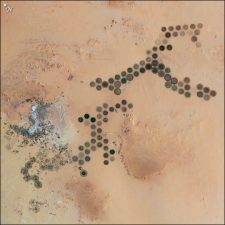 Responding to David de Rothschild’s concerns, IEI attempts to convince Lord Jacob Rothschild that oil shale is good for Israel. Read all about in a letter Green Prophet obtained.
Responding to David de Rothschild’s concerns, IEI attempts to convince Lord Jacob Rothschild that oil shale is good for Israel. Read all about in a letter Green Prophet obtained.
Following our much publicized open letter to David de Rothschild, who is in the running to become National Geographic Adventurer of 2010, Green Prophet was interviewed on a radio station in Iowa about the oil shale exploration planned for Israel’s Elah Valley.
AOL news also covered the story, bringing attention to David de Rothschild’s concern for the potential environmental impact. The eco-explorer wrote to his second cousin, Lord Jacob Rothschild, a new investor in the conglomerate that intends to test its in-situ oil shale technology. That message was then forwarded to Israel Energy Initiatives.
In a four page response (see pdf at the end of this article), IEI assured Lord Jacob Rothschild that every effort has been made to ensure that this project will proceed without causing undue environmental destruction.
The company’s CEO, Relik Shafir also claimed that IEI has proceeded with total transparency and that all relevant documents are easily accessible.
“Furthermore, in connection with our planned Pilot Test, the company commissioned an environmental impact assessment,” Mr. Shafir wrote.
The EIS referred to was commissioned by the company, according to Rachel Jacobson, the spokesperson for the Citizens Coalition to Save Adullam. In most transparent societies, it is necessary to produce an independent environmental impact assessment report. This alleviates any possibility of fudging data to suit the company’s commercial purposes.
Mr. Shafir also claimed that the EIS was submitted to every pertinent regulatory authority and that it is in the public domain.
But the process has not been nearly so accessible or transparent as Mr. Shafir would like Lord Rothschild to believe. Instead, Save Adullam’s legal counsel was only able to obtain a copy of the Ministry of Infrastructure’s license to explore two and a half years after it was issued, and even then they acquired it through unofficial means.
The company’s CEO addressed a host of environmental concerns, claiming that it will neither require excess energy nor water to produce shale oil, and that the local aquifer (at risk of contamination) is several hundred meters below the targeted oil shale.
Until Green Prophet has access to the scientific data that gives IEI such confidence, we can’t fairly comment. We can draw attention to a Forbes report, in which America’s Government Accountability Office draws attention to both water scarcity and water quality as risks associated with oil shale exploration.
“Oil shale development could have “significant” impacts on water quality and availability, but the exact effects are unclear, partly because what’s known about current water conditions is limited and processes for extracting oil are still being researched, the GAO said.”
IEI claims it will be a net producer of water, but whether that is possible is in question. Jeremy Boak, the Director of the Center for Oil Shale Technology and Research said this of water and oil shale:
One major use of water for in situ production would be for steam condensation in a power plant. Because IE will not heat downhole with electricity, this use may be excluded. A second use is for reclamation of the underground, to “steam clean” the rock of any organic contaminants not recovered during production, to protect groundwater.
This is particularly worrying in a country that has precious little water resources, where vegetable prices have doubled and trebled because of water scarcity, and where energy-intensive desalination facilities make up for lack of fresh water.
The CEO also wrote that the quality of Israel’s oil shale is “a world-class resource that is rich, thick, and homogenous.”
Jeremy Boak says it is of “medium grade,” and America’s National Oil Shale Association omits Israel from its list of the world’s top oil shale resources, shedding some doubt on IEI’s hyperbole.
The letter did not address the court petition submitted by the Union for Environmental Defense, or the potential impact the project (not merely the pilot project, but future exploration) would have on the people in the Elah Valley.
Two additional, potential negative impacts noted by Jeremy Boak:
c) Socioeconomic impact. Federal governments collect large royalties on hydrocarbon production. The local impacts occur immediately, but the filtering down of the Federal dollars to states and localities is substantially delayed, and portions are diverted to other needs. On the other hand, at least in western Colorado, rapid development and population not related to hydrocarbon production is not generating royalty revenue, but is having impacts. So a systematic view is important to resolve a broader impact.
d) Surface disturbance. An in situ production block will be largely cleared of vegetation during the life of the production, although well-recognized reclamation approaches can readily restore the land once production and any in situ reclamation is complete. The surface disturbance question comes down to how much surface needs to be disturbed at any one time. For Colorado, this can be relatively moderate due to the richness of the oil shale.
In Israel, the pilot project will occur within one mile of the nearest town, according to Mrs. Jacobson, who adds that this would be “unthinkable in America.” Therefore, the slightest surface disturbance will have a direct impact on the ecological integrity of an area being considered as a UNESCO biosphere reserve.
Shedding even further doubt on its safety, in November Haaretz reported that oil shale caught fire at Israel’s Rotem Amfert plant, which caused headaches and other discomforts in Dimona.
Critics worry that IEI and their wealthy benefactors, including Dick Cheney – whose environmental record is notoriously sullied – are using the Elah Valley as a guinea site for technology that must undergo rigorous testing in the United States before it can be exploited on a widespread commercial level.
Proponents claim that testing should be permitted, but only if appropriate environmental processes are followed.
Please see IEI’s response below:
Israel Energy Initiatives Response to Lord Jacob Rothschild
More on oil shale in the Elah Valley:




Tafline – our scince and evironment material is in Hebrew, but we do have some material in English that we can send you.
Thank you Relik, I would be grateful. I am especially interested in your hydrology and geology reports. Can you send what you have to tafline at greenprophet dot com?
Thanks as ever for your comments. Relik, do you have an English version of your documents?
As someone extensively quoted in the article, I feel some need to respond to a few assertions. Environmental assessments should be reviewed and commented upon on technical merits. In the U. S., companies still pay for the assessments for oil shale leases, even when they are conducted under the direction of the government, and are regularly questioned on this grounds. Some will question independence unless the conclusion suits their own predilections.
The estimates of Israeli resources are brand new, and neither NOSA nor I have had time to fully evaluate them. However, we have had early indications that Israeli resources were larger than earlier values, such as the USGS assessment, which nevertheless recognized the importance of the multinational resource in this area. Homogeneity may be every bit as important as richness when it comes to determining the economic viability of the development. Calling IEI’s numbers hyperbole is, itself, hyperbole, based on very limited research.
Unless there is strong evidence that the oil shale horizon being produced is extensively connected to the deeper aquifer, there is no reason to assume that horizon will require extensive reclamation (steam cleaning) after retorting. So this substantial use of water may be avoided or reduced as well.
The assertion that a surface disturbance akin to the likely impact of development of oil shale envisioned by IEI in the vicinity of a town would be unthinkable in the U. S. is likewise exaggerated. Industrial development occurs in and around urban, suburban and rural communities around the U. S., including oil field development. Regulations are in place to hold companies responsible for their impact. Apparently many feel that these regulations are failing in Israel, but I have not seen strong evidence to support this assertion.
It is frustrating for companies to prepare extensive documentation of their potential impacts and mitigating measures for multitudes of regulatory and permitting agencies, and then be accused of obfuscation. I have no idea whether it is difficult to obtain relevant documents in Israel, but my experience is that the real hazard is being buried by the shear mass of what has been prepared.
My conversations indicate that principals in the parent company of IEI have been interested in producing oil from oil shale in Israel since the 1970s, so to suggest that Israel is being used as a guinea pig site for U. S. development does not accord with the facts. The Chief Scientist is an Israeli, and his interest in U. S. oil shale grew out of his work on the geology of Israel, not the other way around.
Careful evaluation of these efforts does not produce eye-grabbing headlines, or tabulations of more famous people on either side of the discussion. Harold Vinegar has, to my mind, far more to do with this development than Dick Cheney, and I believe that he is a thoughtful and credible scientist.
But careful evaluation is the only way to get at some balanced view of the effects. I do not know whether economics of the IEI process will justify development, or whether the environmental impacts will be acceptable to the Israeli people, but I do note that the ad hominem attack on the proponents (Dick Cheney is involved, so it must be wrong) has been recognized as a logical fallacy since Biblical times.
I would not like to relate to the author’s bias and one sided approach to the subject.
How ever – the author misunderstands the related technology and geolog. Suffice it to say that in the Israeli case – the oil shale process will be a net PRODUCER of water rather than user in a 3:1 ratio.
All the requested and relevant data including hydrology, is available on the website: http://iei-energy.co.il/
It is through lack of knowledge and understanding that the author is fed with disinformation scattered through the article. An example is the quoted fire in Rotem – an Ex-Situ plant which has no relevance to IEI’s In-Situ process.